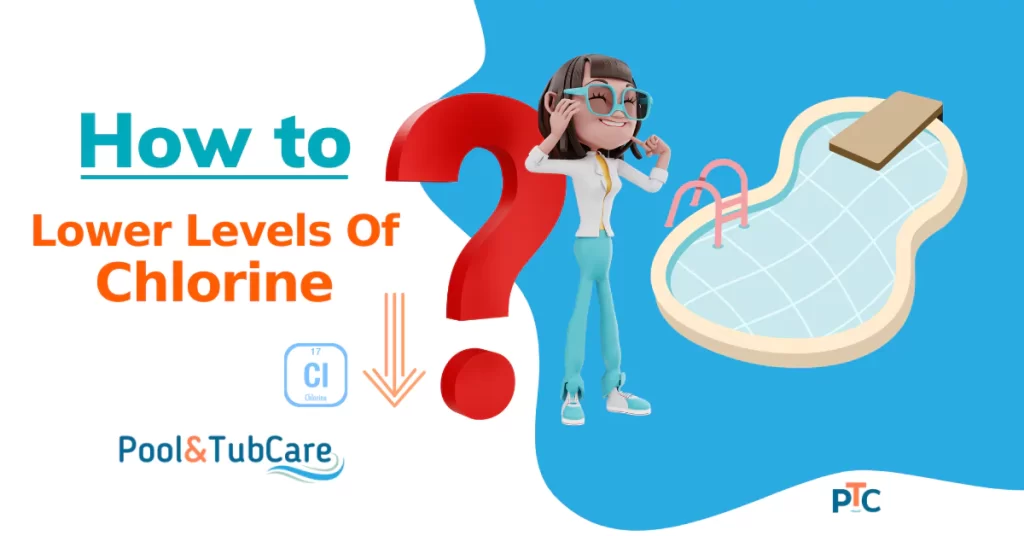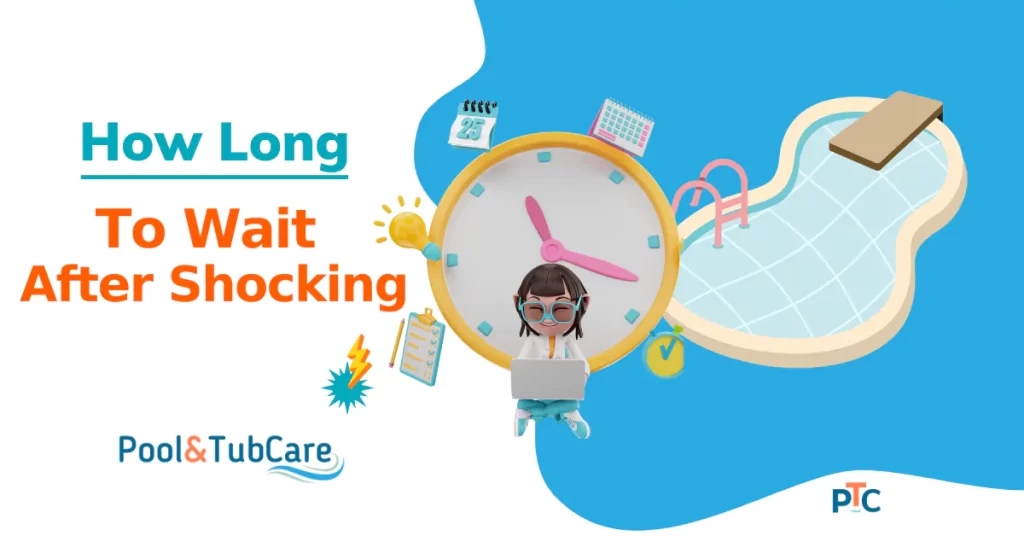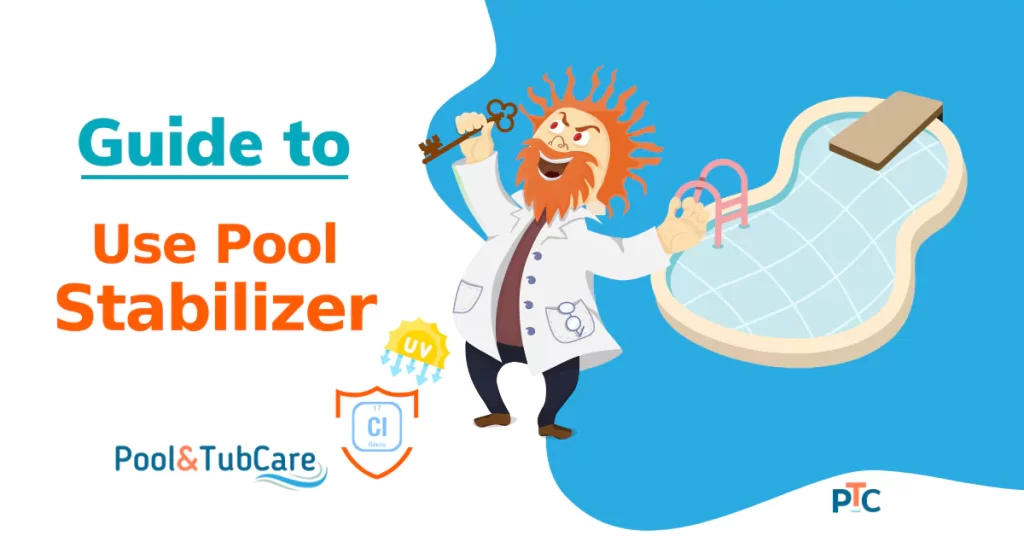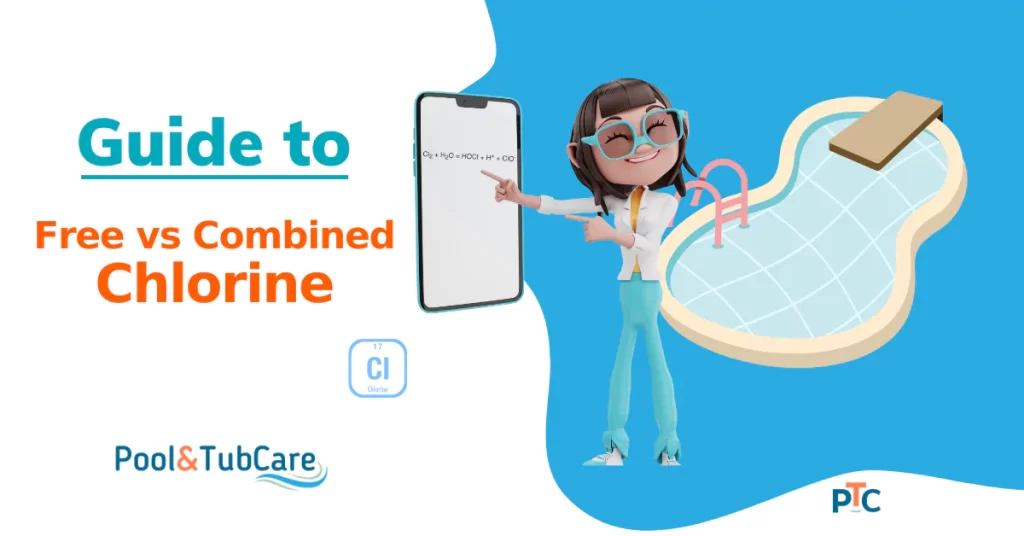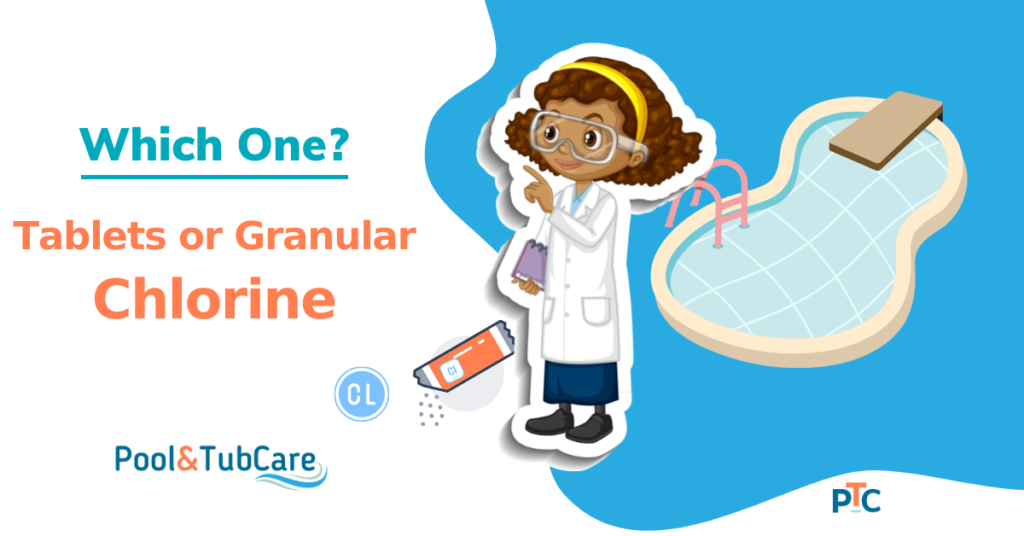Chlorine is essential for keeping a pool clean and maintaining healthy pool chemistry. Chlorine keeps your pool clean by neutralizing organic matter and microorganisms like bacteria and algae.
You need to maintain a constant supply of chlorine in your pool for it to be clean, but if there is “too much chlorine,” it’s not good for your pool and swimmers.
Fortunately, excess chlorine in your pool can be easily corrected.
High levels of chlorines will go down on their own with sunlight. But if you need to lower the chlorine levels urgently, you can use chemicals like Hydrogen peroxide or chlorine neutralizers to reduce it. Another way is to refill/ dilute your pool water. If you have a saltwater pool, you can decrease the chlorinator’s setting to the lowest(10-20%).
Continue reading to find out why the proper chlorine level is critical for your health and safety and how to quickly and effectively reduce the chlorine in your pool.
What Causes High Chlorine Levels?
There are several reasons why your pool’s chlorine levels are too high. Perhaps you just shocked your pool after a large backyard Barbecue and added too much chlorine. Maybe you were on vacation and left too many chlorine pills in the dispenser.
Many pool owners add cyanuric acid to protect chlorine from breaking down quickly due to the sun’s intense UV rays.
Too much chlorine can combine with cyanuric acid if cyanuric acid levels are high and can result in an over-chlorinated pool.
While shocking your pool, you increase the chlorine levels to ten times to reach chloramine breakpoint, they come down on their own in 12 to 24 hours.
But for shocking, you need to use unstabilized chlorine. In case you used stabilized chlorine, or your pool already has high CYA levels, it may increase chlorine levels in your pool.
If your pool is in a beautiful shady corner of your backyard and hardly ever receives any sun, the chlorine you’re adding may not be burning off as rapidly as it would in a pool in full sunlight.
In that case, you may not need to add as much to keep your levels where they should be.
The Ideal Chlorine Levels
The ideal chlorine level in your pool is 1.0-3.0 ppm (parts per million). You should test several times weekly, you should always determine your levels and adjust accordingly.
If your levels are less than 1.0 ppm, your pool will not be adequately cleaned and might grow a variety of harmful organisms.
If the chlorine levels in your pool exceed 3.0 ppm, it is critical that you reduce them to a safe level as quickly as possible.
Effect of pH on Chlorine
Extreme pH variations can also affect how well your pool’s chlorine functions. Chlorine works effective in water with a neutral pH of 7.2-7.6.
If the pool is overly alkaline or has a pH of more than 8.0, the efficiency of chlorine is less than 20%.
A high or low pH can also harm pool equipment, clothes, towels, and swimwear. You need to keep the pH level balanced in your pool.
A simple pH strip test may be used to determine your pool’s pH.
If you’re having trouble balancing the alkaline and acid in your pH levels, try to lower the pH with sodium bisulfate or muriatic acid.
It is possible to raise your pH levels by simply adding a calculated amount of baking soda to your pool water.
Over-Chlorination Risks
While somewhat higher-than-normal chlorine levels in your pool are harmless, constant exposure to an over-chlorinated pool will affect your health in the long term.
If you add more chlorine to the pool water, it will change the pH making it more acidic. High chlorine levels can result in any of the following symptoms:
- Irritant dermatitis, which is characterized by raised itchy red pimples on the skin
- Eye irritation and dilated blood vessels in the eyes
- Asthma and respiratory sickness caused by excess chlorine vapor on the pool’s surface
Respiratory problems can be caused by continuous exposure to over-chlorinated pools, which may make the respiratory system chlorine sensitive.
The majority of these symptoms resolve on their own, with no need for treatment within a few days to a week.
Indicators That Your Pool Has High Chlorine
Your pool’s chlorine is composed of two types of chlorine. Free chlorine is the “good” sort of chlorine that is still available to kill bacteria and microorganisms.
Combined chlorine, also known as chloramines, is the result of chlorine combining with organic waste like sweat and body oils other than bacteria. These chloramines are the cause of the odor of chlorinated pools.
Contrary to popular belief, you cannot detect the amount of chlorine in your pool by smell.
That particular odor is due to chloramines and not chlorine. If you smell that too strongly, it might mean the level of free chlorine in your pool is very less.
In that case, you may need to shock your pool to break down chloramines.
Dry hair, sensitive skin, and sore eyes are all signs of high chloramines in your pool water.
There are simpler and safer ways to determine whether your pool is over-chlorinated.
You can use color strips, testing kits, or electronic testers.
A DPD testing kit calculates the total chlorine count by measuring free and combined chlorine levels. You may also use an OTO kit; however, this just tests the amount of free chlorine in your pool.
These titration tests are the most accurate way to determine chlorine levels in your pool. They will help you better analyze how to lessen chlorine levels in your pool if necessary.
The CDC advises that the chlorine level in your residential pool be between one and three parts per million (ppm).
If the DPD testing kit indicates that your pool’s chlorine levels are greater than usual, there are several options for lowering them.
Seven Different Ways to Lower Chlorine Levels
If chlorine levels in your pool are too high, sunlight will naturally lower them over time. It’s not the quickest technique to obtain results, but it’s a natural chemical reaction in your pool that will cure the high chlorine levels problem over time.
In case tomorrow is the party, and you want to actively reduce the chlorine levels in the pool, there are other methods you can chose from the list below.
1. Stop Adding Chlorine and Start Swimming
The first step, regardless of the method you pick, is to remove all chlorine sources from your pool.
Lowering chlorine levels in your pool may be as simple as not adding chlorine to your pool if your chlorine measurements are only slightly higher than the required chlorine concentration.
Turn off your chlorine feeder, remove the chlorine floater from the pool, and empty the skimmer of chlorine pills. Turn the chlorinator to its lowest setting if you are using a saltwater pool.
Reducing the constant input of chlorine into your pool allows the chlorine that is already in the pool to be used.
2. Sunshine Will Do it For You
When there is bright sunlight, UV rays will break down chlorine in your pool.
Pool chlorine levels can be reduced by up to 90% by uncovering your pool and exposing the water to bright sunlight for at least two hours.
UV rays combine with free chlorine to form chlorine gas, which is then released into the atmosphere.
To attempt this method, stop chlorinating your pool and monitor the chlorine levels to ensure they don’t go below two ppm. Continue to regular chlorination to sterilize your pool after they reach this level.
This method may work more slowly if you use cyanuric acid in your pool. Cyanuric acid is a chlorine stabilizer that is used to assist the chlorine in your pool last longer.
3. Heat the Pool Water
The temperature of the pool water may help break down the chlorine.
If you have the option of heating your pool, consider raising the water temperature to 9°F-10°F over the recommended range for a short period of time. Throughout the day, keep an eye on the chlorine levels.
4. Dilute the Pool
To dilute your pool water, drain it partially and then refill it with fresh water. When compared to other chlorine-lowering methods, this method has significant limitations.
It takes a long time to drain and refill your pool.
Depending on the municipal water rates in your location, diluting the pool water might also significantly increase your water expenses.
It also affects your pool’s pH level and water hardness depending on the supply, which you will need to monitor and carefully regulate once you have finished diluting it.
This method can be a great alternative for pool owners with an increased total dissolved solids level or excess copper or cyanuric acid.
5. Use Hydrogen Peroxide
Hydrogen peroxide is a strong oxidant that reacts with chlorine to form water and oxygen. It is doing its job if you notice little effervescent bubbles in the pool.
Use pool-formulated hydrogen peroxide for the best effects. This product has a greater concentration of hydrogen peroxide than other cleaning products.
At pH values greater than 7.0, hydrogen peroxide is the most effective. Before using this product, test the pool’s pH and adjust the levels to ensure that the hydrogen peroxide properly removes excess chlorine.
6. Use a Chlorine Neutralizing Product
Several chlorine neutralizing products on the market have been mainly developed to lower the quantity of chlorine in your pool without affecting the pH, alkalinity, or hardness levels.
To prevent eliminating too much chlorine and having to re-adjust the levels, add the neutralizer gradually.
Depending on the chlorine in your pool, you may need repeated treatments to restore it to a swimming-safe level.
7. Try Sodium Thiosulfate
Sodium thiosulfate is a less expensive alternative to pre-formulated chlorine neutralizing solutions. The amount you need to add is determined by the volume of water in your pool and the initial chlorine level.
Use this calculator to find out your pool water volume.
A pool skimmer is the best way to add sodium thiosulfate to the pool.
Because sodium thiosulfate stays in the water until it has reacted with all of the chlorine available, it is easy to overshoot and remove too much chlorine. Begin by adding half of the amount advised by the manufacturer.
Then, before adding more chlorine, test the levels again.
The chemical interaction between chlorine and water reduces the pool’s total pH, which can make it overly acidic.
If you use a chemical method to neutralize the chlorine in your pool after it has been sanitized with stabilized chlorine, the cyanuric acid level will remain the same.
The cyanuric acid level rises when you add stabilized chlorine back into the pool to begin sanitizing. After completing any neutralizing treatment, carefully monitor the cyanuric acid and pH levels.
Note: I recommend using methods like adding chemicals only in case of urgent need or in case your pool doesn’t get any sunlight. Otherwise, just stay put without adding any chlorine; sunlight will break down excess chlorine for you. This is also cost-effective and doesn’t alter your pool water’s chemistry.
Lowering Your Pool Water’s Chlorine is Not That Hard
High chlorine is not good for your pool and swimmers. The good news is it will get down in a couple of days on its own if there is no chemical imbalance like a high CYA level.
If you need to lower the chlorine levels fast, you can use the abovementioned methods effectively to get the chlorine amount under control.
Maintaining proper chlorine levels results in a more pleasurable swimming experience and a longer-lasting pool.
FAQs
Here are a few frequently asked questions.
Is It safe to swim in a pool with high chlorine?
No, exposure to high chlorine levels can make you sick and affect epithelial layers of the body like skin, lungs, and eyes.
Don’t swim in a pool if the chlorine levels are over 5ppm. Over time it can also affect equipment in your pool.
How long will it take for the sun to reduce the chlorine after adding tablets?
The answer here depends on your stabilizer level or CYA. The primary purpose of CYA is to act as a “sunscreen” for the chlorine allowing it to remain in the water where you want it.
Without a stabilizer, the sun can break down over 90% free chlorine in a couple of hours. With a stabilizer, it may take 3 to 4 days for the sun to reduce chlorine levels.
Should you shock pool if chlorine is high?
If the chlorine levels in your pool are already high, you should use non-chlorine shock as it will effectively break down chloramine and kill bacteria without adding more chlorine to the pool.
Can too much chlorine make pool cloudy?
Too much chlorine can imbalance the chemical balance and lead to pH imbalance.
Pool water with unbalanced pH can become cloudy, and you need to bring chlorine and other chemical levels to normal.

